
Lomatium is a genus in the family Apiaceae. It consists of about 100 species. Its common names include biscuitroot, Indian parsley, and desert parsley. It is in the family Apiaceae and therefore related to many familiar edible species such as carrots and celery. Native to western Northern America and northern Mexico, some Lomatium species are extensively used by Native Americans in the inland Pacific Northwest as a staple food.

Lomatium roseanum, adobe parsley, also known as adobe lomatium and rose-flowered desert-parsley, is a very rare plant of the Western U.S., known only from northwestern Nevada and southeastern Oregon, and which may also occur in northeastern California. The largest populations occur on the Sheldon National Wildlife Refuge. It is a member of the celery family, the Umbelliferae, and has yellow flowers.
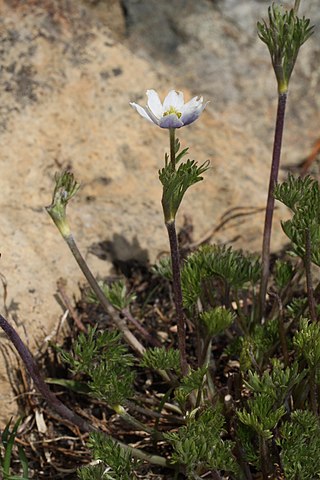
Anemone drummondii is a species of flowering plant in the buttercup family Ranunculaceae, known by the common name Drummond's anemone. It is native to mountains in western North America.

Aspidotis densa is a species of fern in the Cheilanthoid subfamily, known by the common name Indian's dream or Serpentine fern or dense lace fern. It is native to the west coast of North America from British Columbia to California and east to the Rocky Mountains in Idaho, Montana, and Wyoming; there is a disjunct population on serpentine soils in Quebec.

Lomatium columbianum is a perennial herb of the family Apiaceae known by the common names purple leptotaenia and Columbia desert parsley. It is endemic to the U.S. states of Oregon and Washington, mostly along the Columbia River east of the Cascades.

Lomatium grayi, commonly known as Gray's biscuitroot, Gray's desert parsley, or pungent desert parsley, is a perennial herb of the family Apiaceae. It is native to Western Canada in British Columbia, and the Western United States, including from the Eastern Cascades and northeastern California to the Rocky Mountains.

Lomatium howellii is an uncommon species of flowering plant in the carrot family known by the common name Howell's biscuitroot, or Howell's lomatium. It is native to the Klamath Mountains of southern Oregon and northern California, where it is a member of the local serpentine soils flora.

Lomatium martindalei is a species of flowering plant in the carrot family known by the common names Cascade desertparsley and coast range lomatium, native to western North America.
Lomatium shevockii is a rare species of flowering plant in the carrot family known by the common name Owens Peak desertparsley, or Owens Peak lomatium. It is endemic to Kern County, California, where it is known from only two occurrences at Owens Peak, one of the highest points of the Sierra Nevada. It is a plant of the talus and wooded slopes of the high mountains. This species was discovered in 1984 and first described to science in 1988.

Polystichum lemmonii is a species of fern known by the common names Lemmon's holly fern and Shasta fern. It is native to western North America from the Sierra Nevada of California north to Washington. It is also known from British Columbia, where there is a single occurrence in the mountains above the Okanagan Valley.
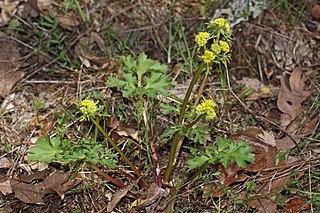
Sanicula graveolens is a species of flowering plant in the family Apiaceae known by the common names northern sanicle and Sierra blacksnakeroot. It is native to western North America from British Columbia to Montana to California, and southern South America, including southern Chile. Its habitat includes mountain slopes, forests, and woodlands on serpentine soils. It is a perennial herb producing a slender, branching stem up to half a meter tall from a taproot, with leaves alternate. The lowest leaves have long stalks and are often attached below ground. The upper leaves are smaller, sparse and often sessile. The leaves are compound, the blades each divided into three deeply lobed, toothed leaflets. The herbage is green to purple-tinged to all purple in color. The inflorescence is made up of one or more heads of bisexual and male-only flowers with tiny, curving, yellow petals. Each head has an array of narrow, toothed bracts at its base. The rounded fruits are a few millimeters long, covered in curving prickles, and borne in small clusters.
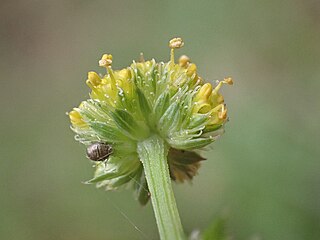
Sanicula hoffmannii is an uncommon species of flowering plant in the family Apiaceae known by the common names Hoffmann's blacksnakeroot and Hoffmann's sanicle. It is endemic to California, where it is known from the Channel Islands and a few locations in the coastal mountain ranges of the mainland, including the Scott Creek watershed in Santa Cruz County. Its habitat includes coastal hillsides and mountain slopes, sometimes with serpentine soils. It is a perennial herb producing a thick stem up to 90 centimeters tall from a taproot. The green or bluish leaves are compound, the blades each divided into about three lobed, toothed leaflets. The inflorescence is made up of one or more heads of bisexual and male-only flowers with tiny, curving, yellow-green petals.
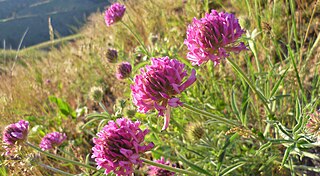
Trifolium thompsonii is a species of flowering plant in the legume family known by the common name Thompson's clover. It is endemic to Washington state in the United States, where it occurs in two counties. One of the largest populations occurs in the Entiat Slopes Natural Area Preserve in Chelan County.

Chaenactis thompsonii is a North American species of flowering plants in the aster family known by the common name Thompson's pincushion and native to Washington State.
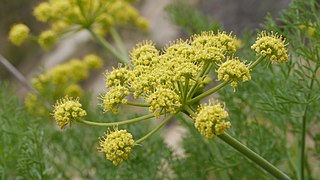
Lomatium thompsonii, commonly known as Thompson's desertparsley, is a perennial herb of the family Apiaceae endemic to Chelan and Kittitas County in Washington, United States. It grows in open, rocky slopes and pine forests. Flowers bloom May to June.
Lomatium roneorum, Rone's desert-parsley or Rone's biscuit-root, is a species of Lomatium native to chalky soils in the Chumstick formation in Washington State. The specific epithet commemorates the surname Rone, as determined by an auction for the naming rights.

Poa curtifolia is a species of grass found on serpentine soils in the Wenatchee Mountains of Washington State.

Oreocarya thompsonii is a species of flowering plant in the genus Oreocarya with the common name Thompson's cryptantha.

Castilleja elmeri is a species of flowering plant in the family Orobanchaceae with the common name Elmer's paintbrush. As with most Castilleja species, this is a facultative root hemiparasite and will usually be seen growing close to a host plant.
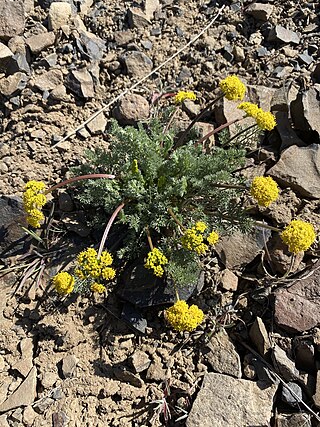
Lomatium quintuplex is a perennial herb in the carrot family Apiaceae, native to the U.S. state of Washington, and known by the common name Umtanum desertparsley. It grows in thin rocky soil on open slopes and is known only from a small region in Kittitas and Yakima counties.



















